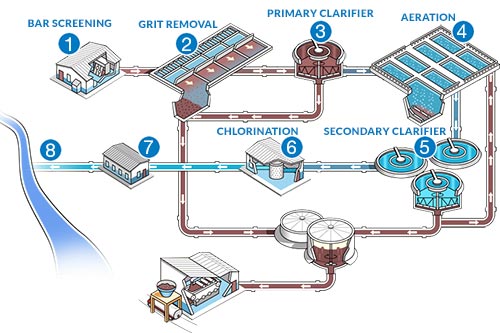Affordable and Sustainable Wastewater Treatment Services Near You
Affordable and Sustainable Wastewater Treatment Services Near You
Blog Article
Understanding Wastewater Therapy Processes and Their Ecological Effect
The ins and outs of wastewater therapy processes play a critical role in mitigating ecological challenges linked with water air pollution. Each phase, from preliminary to sophisticated treatments, is made to attend to specific contaminants, inevitably guarding both public health and marine environments.
Review of Wastewater Therapy
Exactly how is wastewater changed into a secure source for the environment? Wastewater treatment is an important procedure created to get rid of impurities from utilized water, thus protecting public health and safeguarding environments. This procedure begins with the collection of wastewater from residential, industrial, and commercial sources, which is after that directed to treatment facilities.
At these centers, numerous physical, chemical, and biological approaches are utilized to treat the wastewater. Preliminary testing gets rid of huge particles, adhered to by sedimentation to separate heavier solids. Ultimately, biological treatments, such as triggered sludge processes, utilize microorganisms to damage down organic matter. These methods not just reduce contaminant levels yet likewise promote the recovery of beneficial nutrients.
The treated effluent can be securely released right into all-natural water bodies or recycled for watering and industrial purposes, promoting source preservation. Additionally, the treatment process creates biosolids, which can be repurposed as fertilizers or soil changes, even more improving sustainability.
Phases of Treatment Processes
The wastewater treatment procedure generally includes three primary stages: initial, key, and secondary therapy. Each phase serves a distinctive function in minimizing the contaminant lots and guaranteeing the effluent satisfies ecological requirements before discharge.

The key therapy stage concentrates on the physical separation of put on hold solids from the wastewater. With sedimentation, heavier particles work out at the base of sedimentation storage tanks, creating sludge, while lighter products, such as oils and oils, float to the surface area and are skimmed off. This process dramatically decreases the natural and inorganic load in the wastewater.
Second therapy is a biological procedure intended at further lowering the concentration of natural matter. This phase is crucial for accomplishing the needed biochemical oxygen need (BODY) reduction, ultimately leading to cleaner effluent ready for discharge or further treatment.

Advanced Treatment Technologies
Adhering to the additional therapy processes, progressed treatment technologies play a crucial role in more boosting the top quality of Our site treated wastewater. These innovations are designed to get rid of recurring impurities that are not successfully removed during primary and secondary treatments, guaranteeing the effluent fulfills stringent regulatory standards.
Amongst the extensively utilized innovative treatment approaches are membrane layer filtration, reverse osmosis, and advanced oxidation procedures. Membrane filtering, consisting of microfiltration and ultrafiltration, works in dividing fine fragments, virus, and colloids from the water (Wastewater). Reverse osmosis makes use of semi-permeable membranes to get rid of liquified solids, causing high-grade water ideal for numerous applications
Advanced oxidation processes (AOPs) utilize solid oxidants to break down organic pollutants, including pharmaceuticals and individual care products that are immune to conventional treatment. These methods boost the biodegradability of complex substances, facilitating their elimination.
Another considerable innovation is the usage of organic nutrient removal procedures, which particularly target nitrogen and phosphorus, avoiding eutrophication in obtaining water bodies. Generally, sophisticated therapy innovations are essential for achieving greater degrees of purification, promoting water reuse, and protecting public wellness while addressing the challenges connected with wastewater management.
Ecological Advantages of Therapy
Numerous environmental advantages arise from reliable wastewater therapy processes that add to ecosystem health and sustainability. Mostly, these procedures significantly minimize the release of hazardous toxins into all-natural water bodies, which assists keep marine environments. By getting rid of contaminants such as hefty metals, nutrients, and microorganisms, dealt with wastewater alleviates the threat of waterborne illness and advertises biodiversity in aquatic settings.
In addition, right here wastewater therapy facilities often employ sophisticated modern technologies that enable water recycling and reuse. This practice not just saves freshwater sources yet likewise reduces the need on all-natural water products. Improved nutrient removal from wastewater can additionally avoid eutrophication, a process that results in algal blooms and succeeding oxygen exhaustion in marine systems.
In addition, effective treatment processes can minimize greenhouse gas discharges, specifically methane and laughing gas, which are frequently launched during untreated wastewater decay. By capturing and utilizing biogas from anaerobic digesters, facilities can transform waste right into eco-friendly power, therefore adding to a reduction in nonrenewable fuel source dependency.
Challenges and Future Patterns
While the environmental advantages of wastewater therapy are clear, a number of obstacles continue that impede ideal outcomes in this field. One major issue is aging framework, which typically results in ineffectiveness and raised functional prices - Wastewater. Many treatment plants were created decades ago, and their capabilities do not line up with contemporary demands, view it which consist of stricter regulatory standards and higher quantities of wastewater as a result of urbanization

Looking ahead, there is an expanding focus on resource recuperation and round economy principles within wastewater treatment. Innovations such as anaerobic digestion, which can produce biogas, and progressed filtration technologies are acquiring grip. These techniques not only enhance therapy efficiency yet likewise advertise sustainability.
Ultimately, addressing these obstacles needs cooperation amongst stakeholders, investment in modern technology, and a dedication to ongoing study. By accepting these trends, the wastewater therapy market can progress to fulfill the demands of a transforming setting and culture.
Verdict
In verdict, wastewater therapy procedures play a crucial role in improving ecological quality and public health. The multi-stage treatment framework, coupled with advanced technologies, efficiently minimizes contamination and promotes lasting water management.
Report this page